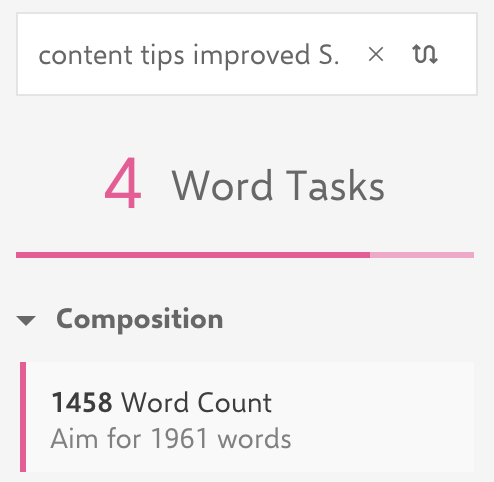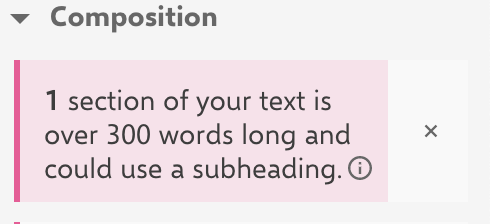Top SEO Tip: Never lose sight of who your target audience is.
It’s really that simple. Google rewards sites that completely answer the key phrase the searcher has entered into their search bar.
If you present your content to the reader in the manner that they are expecting, you will improve your SEO ranking.
Tip #1: Know Who Your Audience is
Before you begin writing, take a few minutes and put yourself in the shoes of the searcher.
Ask yourself these questions:
- What keywords are they searching for?
- What sort of results are they expecting?
I suggest going to sites where your target audience might visit. For example, you’re writing a back-to-school, must-have clothing article for teenage girls. Visit the YouTube channels of the most popular stars for your age group. Follow social influencers on Instagram. Get to know your audience’s likes and dislikes.
When you begin writing keep thinking of the reader.
- Are they technical or not technical?
- Will they be expecting image-rich content?
- Are they looking for an in-depth explanation or a quick answer to their question?
As with the example above, a back-to-school clothing article would be expected to have many images of put-together outfits. The searcher would also expect links to where to purchase the items.
An article on the pros and cons of cotton cloth for teenage girls would be expected to have fewer images and links. It would include more scientific vocabulary and in-depth explanations.
Tip #2: Know Your Ideal Reading Grade Level
Read the top sites you’re competing against for SEO ranking. Notice their style. Is it conversational? Authoritative? What keywords do you see sprinkled throughout?
Write to the reading grade level of your audience. Make sure you are using expected vocabulary. If the reader is looking for a scientific answer use scientific terms. If they aren’t, then keep vocabulary simpler, so they aren’t intimidated.
Your reading grade level must be targeted for your audience. If not, they will exit your site after the first couple of sentences. This negatively impacts your SEO.
Tip #3: Find a Product That Does the Research for You
INK is the name of a product I’ve been developing for content writer’s like you. It’s a one-stop-shop for all your SEO needs.
It will tell you who your audience is allowing you to focus on your writing.


The screenshot from INK informs me that I need to aim for a reading grade level of 10. I’m at 10.22. I’ll have to read through my content and find the vocabulary that I used that is too complex.
Tip #4: Readability is Key
Readability is the ease in which your target audience is able to digest written text.
Grammar
One factor in readability is the proper use of grammar. A site that has typos, poor punctuation and misuse of words will give a bad impression of the author. They’re deemed not an authority on the subject matter if they are thought to be illiterate.
The reader doesn’t want to slog through typos in the prose to find their answer. Google looks for this. It will punish the site by ranking it lower. Keep in mind that this will happen even if the information is presented correctly with high authority.
Tip #5 Keep Sentences Short and Simple
Don’t overcomplicate anything you don’t need to. Don’t use eight words if you can say it in four.
If a sentence has too many words, the reader gets lost in the meaning. Searchers are looking for the most concise and informative answer to their question. Getting too wordy makes the reader exit the site early.


Try to not combine thoughts in one sentence. This can be confusing to the reader. Ever heard the phrase “it makes sense in my head?” This is very true when it comes to content writing.
Tip #6: Be Conversational
Think about how you would explain the answer to someone who asks you the question in person. If you keep this in mind, you will naturally use less complex vocabulary and speak in shorter sentences. This better conveys your point.
Use this as a good opportunity to insert your personality. You can add humor to improve your content readability. Think of adding a funny but relevant picture to illustrate a point.
Read your content out loud. If it doesn’t sound great to you, it will most likely not appeal to your audience. This will also help you uncover missing words and other typos.
Tip#7: Improve Your Readability
INK performs a number of tasks that improve your site’s readability. It checks for grammatical errors and misspelled words.


It offers spelling suggestions. Here I misspelled the word “checks.” It offers possible suggestions as to the word I was attempting to type.


INK ensures that your sentences are short and concise and compares your tone with your competition.
INK’s analytics improve my content for the best SEO ranking possible.
Tip #8: Be More In-Depth
The better job you do of answering your searcher’s question or solving their issue, the higher SEO ranking your site will receive.
What’s the best way to do this? Ensure that you are not only answering the question but providing informative details.
For example, someone searches for “what’s the melting point of milk chocolate.” A simple reply would be “between 86 and 90 degrees Fahrenheit.”


This is the screenshot of the number one, highest ranked site on Google. It’s clear that the writer not only answered the key phrase. They added additional tips on how to melt the chocolate and gave a recommendation for a tool that might make it easier. There is also an embedded link that takes the reader directly to the site if they’d like to purchase one.
This is a great example of writing rich content, which is why it ranked number one.
Tip #9 Compare the Length of Your Content With the Competition
The key phrase I entered for this article is “content tips improved SEO.” As I’m writing, INK shows me my word count and compares it with the highest ranking sites.


When I was developing INK, I knew this would be a huge advantage for usersto improve their SEO ranking.
Tip #10: Establish Yourself as an Authority.
This is a complex topic and can be its own 2,000-word article. For the purpose of providing content tips for improved SEO, I’ll stick to the basics.
Answer the Question
Part of establishing your authority on a subject is how well you solve the searcher’s problem or thoroughly answer their question. This seems obvious. However, the Internet is littered with sites that have failed to do this.
Articles that are able to answer the question have readers who spend more time on their page.
Think about it. You type in “what’s the average temperature in Rome in July.” You expect an article that gives you the temperature range, maybe suggests items to pack and gives advice on how to cool off.
If the searcher stumbles on a site that lists the temperature range but then discusses the history of The Colosseum, it’s quite likely the searcher will exit.
Their question was answered in the way they were expecting. However, their expectations were not met. They didn’t linger on the page getting additional details they might need for their trip.
Tip #11 Sound Like an Expert
If you’re going to be an authority on a subject, you should sound like you are. This is where passive voice can affect your SEO ranking.


As I’ve mentioned numerous times, Google rewards sites that answer the question. If the author overuses the passive voice, they sound wishy-washy. This leads readers to place lower confidence in the answer.
Tip #12: Know What Voice is Right for You.
I love this feature of INK. Every set of key phrases has a certain number of passive voice usage that doesn’t impact the SEO ranking. I developed INK to look for the usage of passive voice in the competing searches. This is customized advice for your unique key phrase.


But it’s not just reducing your passive voice use that can help improve your authority. Effective headers and page layout can work wonders for your site.
Headers are a larger font size and are the first thing read by your audience. They introduce a subject soon to be discussed. A strong header will set the expectation for what the reader should find in the subsequent content.
Subheaders are a smaller font and help break up lengthy prose. They give the reader a sense of hierarchy.


As the example demonstrates, a well-organized article is significantly easier to digest. Your reader will hang out longer. This gives great feedback to Google about the readability of your site.
Tip #13: Use Images Correctly
Pictures break up long prose. A colorful image stops the eye giving the brain a chance to absorb what it just read.
They also act to segment content into different sections. Think of pictures as a natural page break. They are a type of subheading.
What is most important regarding the use of images is that they can graphically enhance your explanation of the key phrase. This will increase your chances of organic authority building. People will share if they understand.
A general rule of thumb try to use an image every 100 words.
We all get caught up in our writing and forget to add breaks. I developed INK to look at your content and suggest when it’s time to use a header or subheader.


Keep in mind the example I included above when thinking about page layout. The layout of your content matters for your SEO ranking.
Tip #14: Optimize Your Images
Above, I discussed using images to improve readability and as a natural page break.
This is different. Pictures and other images must be in the correct file format and size if they are to improve your SEO ranking.
Large images can increase your page loading time. If it takes too long for your page to load, this affects your SEO ranking. Your searcher doesn’t want to wait on you.
Resize or compress your images to optimize them.
Here’s a great tip. Use your images to sneak in keywords by naming them accordingly.
For example, you have a website that sells vegetable seeds. Don’t name the image “seed packet2.” Instead, use a name like “maroon carrots.”
Also, use keywords in your image caption.
One of the many advantages of using INK to improve your SEO ranking is that it automatically optimizes your images when you upload them.


It has a built-in feature that grades your alt text score. It also has a field for entering your image caption. INK makes optimizing images super easy.
Tip #15: Optimize Your Meta Description
A meta description is the text under the link that describes the page when someone does a Google search.


Google has published tips on how to create the ideal meta description. Here are the three most important:
You need to recognize what an important influencer meta description is on your SEO. That’s why INK has a special feature that analyses and optimizes it for you.


Just by implementing the content related tips above, you will improve your SEO. Focus on your reader. Understand what they’re looking for. Write for them.
If you want some extra help, download INK. It’s 100% free to use. There aren’t ads or free trials. It takes so much of the guesswork out of SEO ranking.

Comments (0)
Least Recent